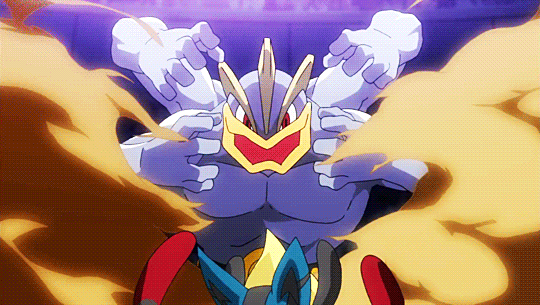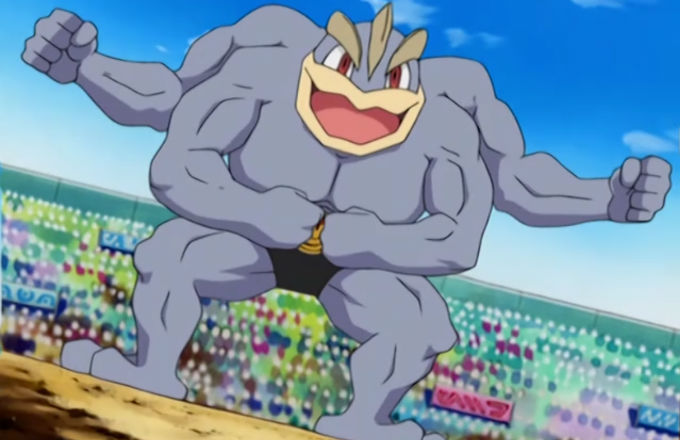Last updated on January 12th, 2022 at 02:23 pm

Here’s something fun we can do for Pokemon this week.
If you missed it, I started with a Brock workout that’ll start our brand new category for “Cosplay Workouts and Guides”.
I also mentioned the fact that we’ve seen Misty before as well, and that one also basically revolved around being a cosplayers workout routine.
That one was back when Let’s Go Pokemon released on Nintendo Switch, and now this week I’ve been binging the brand new Pokemon Masters mobile game.
I wonder who we’ll see when Pokemon Sword and Shield come out in November…
Machamp Stats:
Height: 5’3
Weight: 287 lbs
Real Name: Machamp
Powers: Yes
Machamp may only be 5’3 but he packs a big punch.
And, if you’ve seen the heights on some of our trainers, you’ll know 5’3 actually isn’t THAT short.
Vegeta were tied Wolverine for the shortest spot among comic characters we’ve seen at 5’3, prior to the Teenage Mutant Ninja Turtles coming in at 5’2, (and Gimli even shorter) – but Damian Wayne (Robin) is only 5’4. Goku isn’t that tall either, though, standing only 5’7, with Miles Moralesonly an inch above him.
One Punch Man falls in at 5’9 right there with Ryu, Nightwing at 5’10, and then Spider-Man, Daredevil, and Green Arrow coming in around 5’11 and Beast joining them.
We’ve had Superman and Eddie Brock’s Venom at 6’3, and Captain America, Scorpion and Batman at 6’2, and Carnage at 6’1. Thor and Cyborg are towering over them at 6’6, Thanos and King right there with them at 6’7, Bane at 6’8, and Deathstroke right below at 6’5, and Black Manta at 6’4.
Ronan and Sagat are 7’5, and Doomsday came in at 8’10, and I doubt any characters are touching that anytime soon.
But, don’t worry if you’re not the same height or weight range.
We write these routines to be utilized by anyone and everyone.

Grab you Anime Calisthenics Workouts Booklet and Unleash Your Inner Superhuman!
Machamp Diet and Nutrition
**Keep in mind: this section will be nearly identical for each hero, unless I mentioned differently (for example someone like Hellboy may get something specifically different)**
Every hero needs to still have a good diet.
Unfortunately we can train like them, but I don’t think any of us are suddenly getting their powers, or the ability to magically stop caring about nutrition.
You can’t out train your diet, so I want to still give some pillars for nutrition.
You can start by checking out The Nutrition Pillars on the site, but I’ll break down some more information for you guys as well.
Guys like Dwayne Johnson and Kevin Hart incorporate 80/20 dieting with big weekly cheat meals, Hugh Jackman, Tom Hopper, Benedict Cumberbatch and Terry Crews utilize intermittent fasting (something I use daily as well), Ariana Grande, Mustafa Shakir and Madelaine Petsch are vegans, Brandon Routh and Frank Grillo opt for paleo, and tons of others utilize their own variations as well.
It’s all about sustainability.
AND, there are a thousand different ways to reach your goals, so finding the most sustainable way is what’s important.
Which is why our Academy utilizes multiple different Nutrition Classes (Greek Gods, Vikings, Spartans, Hunter Gatherers, Monks, Samurais, Minimalists, SuperHumans) to allow people to choose what is right for YOU!

Take The Anime Workout Placement Quiz Now!
Machamp Workout Routine Research
We’ve made it to “the fun part”.
And, if you don’t know by now, I say that every single time we get to the workout routine research section for character workouts.
This is where I get to break down the “how” and “why” of the workout we’re going to build based on the characters, in this case Machamp’s, powers and/or abilities.
Here’s a brief bio for Machamp from his Wiki:
Machamp is a large, humanoid Pokémon with four well-muscled arms. It has bluish gray skin, red eyes, and pale yellow lips. On its head, there are three brown ridges right above its eyes. It has two arms on each side of its body: a pair located in the normal position, and another pair directly above that attaches on the top of the shoulders. It has black markings that resemble briefs and wears golden power-save belt that resembles a championship belt. Its legs have considerable muscle tone, and its feet have two toes each.
He’s also shown to have been since in multiple games (actually quite a few), Pokken Tournament, and Detective Pikachu, on top of his appearances in the shows, with his main appearances coming as Giovanni’s Pokemon (Giovanni is the leader of Team Rocket).
Machamp, while a fighting Pokemon with the ability to throw rapid punches and also defend himself with the use of his other two arms, is also usually shown to have an extremely high power gauge due to his massive strength.
Machamp evolves from Machoke who also resembles that of a bodybuilder, and evolves from the much smaller Machop.
For this one we’ll be focusing on:
- Training like a Pokemon
- Strength
- Mixed Martial Arts
- The muscular Machamp physique
Think you can handle it?
Check out all The SHJ Programs and start unleashing your inner SuperHuman.
The Machamp Workout Routine

Training Volume:
3-5 days per week
Explanation:
While I do want to make this workout fun and beginner friendly for the Pokemon fans out there who aren’t ready for strongman events like Machamp might be ready for; I also want to add in some twists and fun that get us in the feel of the Machamp specific Pokemon. Machamp is a fighting type Pokemon so I’ll be sharing some snippets from some of our MMA styled routines, but I’m also going to base this workout around the use of stones and rocks; which I feel is most suitable for a “Pokemon” styled training.
The Machamp Workout: Weekly Schedule
Monday: Full Body Rock Training
Tuesday: Atlas Stone Training or Mixed Martial Arts Day
Wednesday: Full Body Rock Training
Thursday: Atlas Stone Training or Mixed Martial Arts Day
Friday: Full Body Rock Training
Saturday: Off Day
Sunday: Active Off Day (Hiking, Walk, Sports, Etc.)
The Machamp Workout: Beginner Rock Training
Explanation:
For this one we’re going to literally be training with big rocks! Head to the beach, head to a place where you can find some stones. Head anywhere that there’s a supply of some big rocks to use for this one!
Workout:
Rock [Goblet] Squats
3×10
Rock [Kettlebell] Swings
3×10
Rock Squat Clean (similar to a Medicine Ball Squat Clean)
3×10
Rock Side Throw
3×10 each side
Rock Soccer Throw (Overhead Throw)
3×10
Rock Overhead Backward Throw
3×10
Rock Slam (similar to Ball Slams)
3×10
Stiff Arm Overhead Rock Walk (or Lunges)
3×10
The Machamp Workout: The Atlas Stone Training (Advanced)
The Guides I will be sharing for the following Atlas Stone Training are provided by Bodybuilding.com and Muscle and Fitness.
The Atlas Stone Load
Use this step-by-step guide to loading an Atlas stone:
- Straddle the stone with a wide stance. Have the stone between your legs. Imagine a steel rod runs through your ankles and the center of the stone.
- Initiate the lift by bending over and cupping your arms around and under the stone. Crush it with a strong arm and chest squeeze.
- Grasp the stone hard. Drive your hips down while pulling the stone into your body toward your groin. This can’t be achieved without a hunched lower back. Lower back and rounded back strength are crucial to successful, injury-free stone lifting and MMA competition.
- From the lap, maintain a solid squat stance and explode the hips forward and upward, rolling the stone up your body and transferring your hands from underneath the stone to the top of it. In doing so, you will stand as tall as possible in order to load the stone. The result is triple extension: ankle, knees, and hips. Always maintain a tight squeeze on the stone, just as you would an opponent.
- Load the stone onto the platform. I use loading platforms or two large tires stacked on each other. Always ensure you have a spotter ready to steady the stone if needed. Return to the floor and repeat as required. Thick gym matting is recommended to drop the stone on.
Atlast Stone Zercher Squat [Very Advanced]
This is an advanced version of a Zercher squat employed only when the athlete is suitably developed and stands to gain something from the exercise.
Follow the steps below to execute correctly:
- Straddle the stone with a wide stance. Have the stone between your legs. Imagine a steel rod runs through your ankles and the center of the stone.
- Similar to an Atlas stone load, bend and cup the stone with your arms in a crush grip. Drive your hips down, and pull the stone into your lap.
- From this position, maintain a solid squat stance and explode upward until upright. The stone should be grasped and held isometrically, giving increased upper back and chest engagement.
- Ensure you have a wider-than-shoulder-width stance. Lower under control while maintaining an upright posture and grasping the stone tight into your body. Pause at the bottom position, then repeat. Drive up, contract your glutes, and press through your heels.
Walking Lunges with Atlas Stones
If holding the stone at your shoulder, use one that’s 75% of your body weight. If the stone is on your gut use 60%. Do as many sets as necessary.
- Squat down and wrap your arms around the stone. Deadlift it up to your lap. From there, either roll it to your shoulder or stand up and hold the stone at your gut.
- Once you’ve secured the stone in position, step forward and lower your body toward the floor until your back knee gently kisses the ground. Keep your upper body tall.
- Stand up out of the lunge by driving through the heel of your front foot and bring the back foot up to meet the front foot. Repeat for an equal number of reps on each leg.
QUICK TIP: Once you’ve gotten the hang of it on your dominant shoulder, try the opposite side. It will be much more difficult and require more core stabilization.
The Machamp Workout: Fighting Pokemon Style!
Here’s a snippet from the Daredevil Training:
Head Movement:
Crucial not only in Boxing, but all forms of combat. Used primarily not just to avoid, but to set up your strikes. A moving target is much more difficult to hit. The best way to practice this is with an partner using pool noodles. Have your partner swing at your head in straight and curved motions, simulating straights , uppercuts and hooks Doing this injury free drill will assist in turning flinching into slips, Parrys, Shoulder rolls , and bob n weaves
Bob n Weave to the Right or Left
Best Used when you’re approaching and getting into range. As soon as your opponent throws a punch, you quickly bend at the knees (not your waist) and move your head (like in a “V” or “U” shaped motion) stepping to the outside of the punch. Remember to keep your weight centered at all times. If you’ve done it correctly, you should end up on the outside of your opponent’s punch when you come back up,
Advantages:
- Off opponents’ center line
- Able to counter quickly
- Loaded for powerful counters
Disadvantages:
- Not effective on straight punches
- Wide open if faked
- Not effective for Uppercuts or multi combos
The Parry
Slightly deflecting your opponent’s punch away with your hand using the same side (when they throw a left you Parry with your right and vise versa) Never Reach across!!
Advantages :
- great for power , straight and long punches as well as push punchers
- creates vulnerability for counters, make them off balance or slows down arm recovery
- tires opponents, especially long-armed and power-punchers
- useful for shorter fighters to deflect punches to get inside
Disadvantages:
- ineffective against fast/light/non-committed punches,& curved punches
- not always effective against combinations
- can leave you open if you get faked
- difficult to do at close range
- not helpful against body punches
Shoulder Roll or Fade Right or Left side
The shoulder roll is naturally the next step up from the parry technique. Instead of deflecting punches with your hands, you use your body now. The shoulder roll is incredibly effective because your body can roll off your opponent’s best shots with ease ,it relies on rhythm for defense while neutralizing entire combinations at even close range.
Advantages:
- effective and easy against multiple punches
- frees up the hands for faster counter punching
- covers both head and body easily
- can work when unable to see momentarily or off-balanced
- will deflect power Punches even when they land
- saves shoulder energy & gives tricky counter angles
Disadvantages:
- ineffective/unnecessary against weaker punches it can also leave you highly vulnerable if you get faked and/or roll in the wrong direction
- less effective in cross-stance , extremely vulnerable to Leg kicks and take-downs in street, Thai Boxing or MMA
Slipping to the Right or Left
Slipping requires complete evasion of the punch by displacing the head or body to one side, MOSTLY by going to the outside of the oncoming punch,in a” V” step ice skating motion. .
Slipping is the best way (sometimes the only way) to counter against really fast opponents. On occasion it’s the only way to close distance against a taller opponent, .
Advantages:
- hands and body completely free to counter instantaneously
- creates huge vulnerabilities in opponent (they are wide open after missing)
- avoids punch entirely, no contact (assuming slip was successful )
- create escapes (great way to escape when trapped in the corner)
- allows you to advance forward while defending
- complete evasion easily breaks your opponent’s punching rhythm (combo-breaker)
- Used to set up position for counters
Disadvantages:
- requires lots of practice and skill
- highly vulnerable if caught or faked
- not recommended against multiple punches
- ineffective against body punches
Now that we have a basic understanding, work them into your shadowboxing, focus mitt or heavy bag session. Remember your striking table
- Jab
- Cross
- Hook
- Uppercut
- Left Upper Cut
- Right upper cut
Now work on:
Slip left, slip right
Bob n weave Left then Right
Slip Left, shoulder roll left, bob n weave left, repeat on other side.
Now add strikes, using your movement to position you.
1-2-1-2 slip Left, Slip Right
1- Shoulder roll Right -2-3-2
Bob n weave Right- 6-3-2
1- slip Left
2 -slip Right
1-2-3-4- bob n weave Right
3- bob n weave Left-3
2- slip Right -2
1-parry Right -2 Parry Left -shoulder roll Right -2
1-2-1-2- shoulder roll Right- 2-3
1-2-3 Slip Left , Rear Slip Left-Shoulder roll Left
Parry Left-2- Bob N weave Right-2-3
Slip Left -5-4-3
The best defensive technique?
Like the Super Soldier Serum, it does not exist. Use the one that fits your situation and feels the most natural in that moment. If you have to think about it too much, its not natural. Evade your opponent’s punches any way that you can and be sure to counter immediately Different techniques will work against different opponent’s styles. Great Fighters are forever adapting their offense to get around opponent’s defense, so keep changing up your defensive game to keep up.
Join The Superhero Academy and start unleashing your inner SuperHuman.




Sick bro, im machamp now thanks